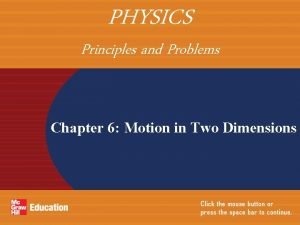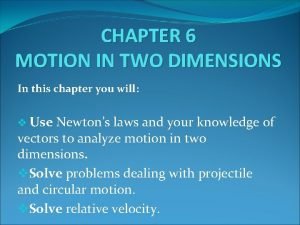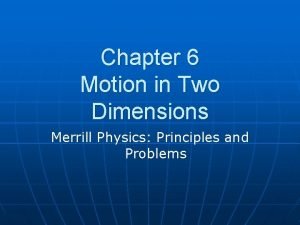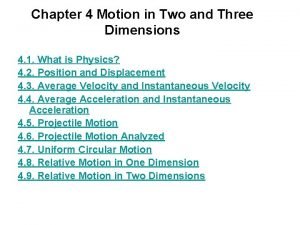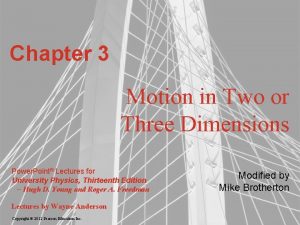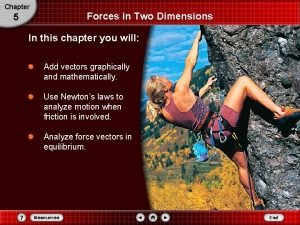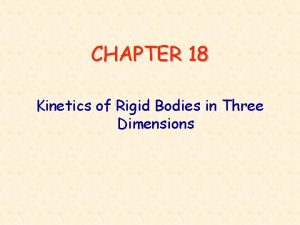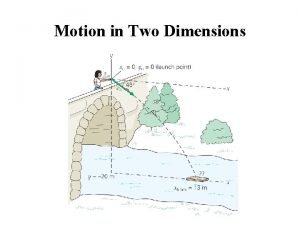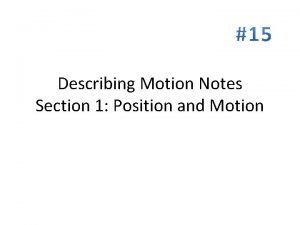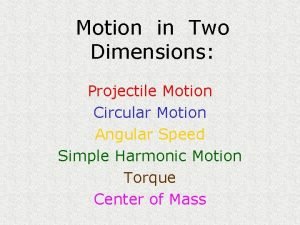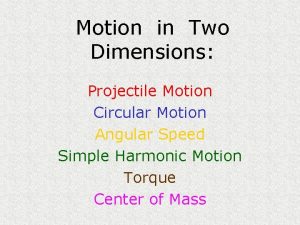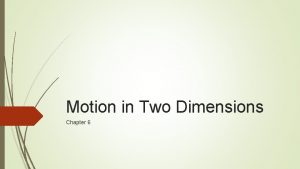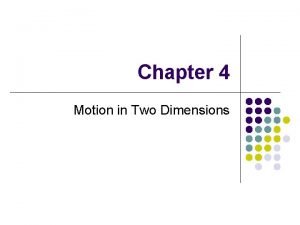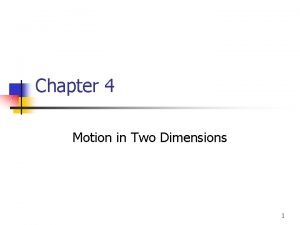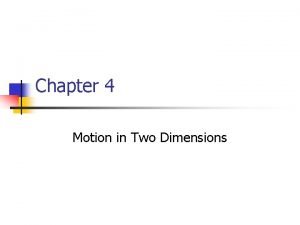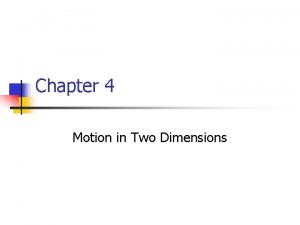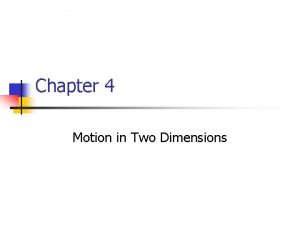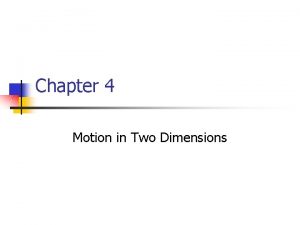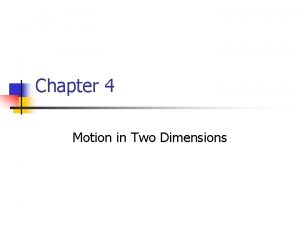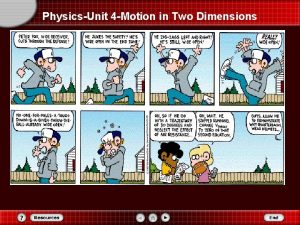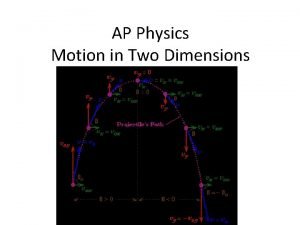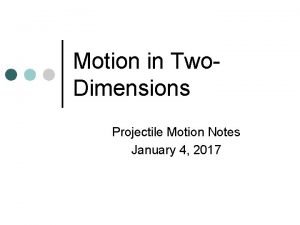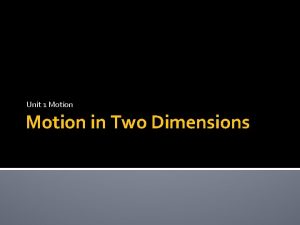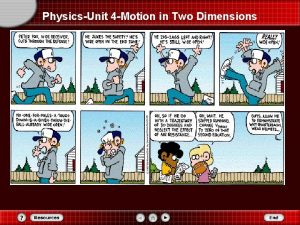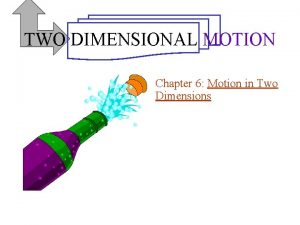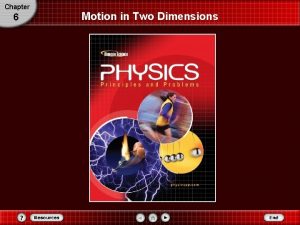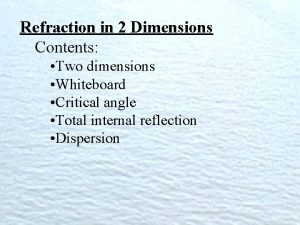Chapter 3 Motion in two or more dimensions



























- Slides: 27

Chapter 3 Motion in two or more dimensions

Two dimensional motion

Vector Notation

Example

Example

The vertical and horizontal components decouple

Vertical and horizontal decouple

1 D equation splits into 2 D Similarly for the velocity:

Free Fall (Projectile Motion)

The General Picture

A batted baseball A baseball flies at speed v 0=37 m/s at an angle of α 0=53. 1°. Find: a)The position, velocity (magnitude and direction) of the ball at t=2 s. b)The time when the ball reaches the highest point and the height at that point. c)The horizontal range (the horizontal distance form the starting point to where the ball hits the ground).

First find the initial velocity v 0 x, v 0 y v 0 x

Velocity (magnitude and direction)

The highest point

Horizontal range To find the horizontal range, we have to first figure out when the ball hits the ground.

Different initial and final heights You toss a ball from your window 8 m above the ground. The ball leaves your hand at 10 m/s at an angle of 20° below the horizontal. How far horizontally will it hit the ground?

First find the initial velocity v 0 x, v 0 y. v 0 x v 0 y

Find the time it hits the ground

Find the horizontal distance

Circular motion

Acceleration of Circular Motion

Centripetal acceleration • Even though the speed of the object is constant, the velocity is constantly changing because of the changing direction. That is why the acceleration is non-zero. y v (x, y) r x

Must remember this: Using this you can convert freely among ω, T, f and v.

Centripetal force and acceleration

Uniform Circular Motion A fighter pilot flying in a circular turn will pass out if the centripetal acceleration he experiences is more than about 9 times the acceleration of gravity g. If his F 18 is moving with a speed of 300 m/s, what is the approximate diameter of the tightest turn this pilot can make and survive to tell about it ? (a) 500 m (b) 1000 m (c) 2000 m

Solution 2 km

 Lirik lagu more more more we praise you
Lirik lagu more more more we praise you More more more i want more more more more we praise you
More more more i want more more more more we praise you Physics: principles and problems chapter 6 answers
Physics: principles and problems chapter 6 answers Rafi is pulling a toy wagon
Rafi is pulling a toy wagon Chapter 6 motion in two dimensions
Chapter 6 motion in two dimensions Chapter 6 motion in two dimensions answer key
Chapter 6 motion in two dimensions answer key Motion in two and three dimensions
Motion in two and three dimensions Motion in two or three dimensions
Motion in two or three dimensions A factory conveyor belt rolls at 3m/s
A factory conveyor belt rolls at 3m/s Motion diagram physics
Motion diagram physics Chapter 5 displacement and force in two dimensions
Chapter 5 displacement and force in two dimensions Chapter 5 forces in two dimensions test
Chapter 5 forces in two dimensions test Chapter 2 motion section 1 describing motion answer key
Chapter 2 motion section 1 describing motion answer key The main difference between speed and velocity involves
The main difference between speed and velocity involves Motion section 1 describing motion
Motion section 1 describing motion Kinetics of a rigid body
Kinetics of a rigid body 5 apples in a basket riddle
5 apples in a basket riddle The more you study the more you learn
The more you study the more you learn Aspire not to
Aspire not to Law of inertia meaning and example
Law of inertia meaning and example Knowing more remembering more
Knowing more remembering more The more i give to thee the more i have
The more i give to thee the more i have More choices more chances
More choices more chances Human history becomes more and more a race
Human history becomes more and more a race Vy=gt
Vy=gt Two dimensions of political ideologies
Two dimensions of political ideologies Horizontal velocity projectile motion
Horizontal velocity projectile motion Describing motion notes
Describing motion notes


